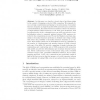Free Online Productivity Tools
i2Speak
i2Symbol
i2OCR
iTex2Img
iWeb2Print
iWeb2Shot
i2Type
iPdf2Split
iPdf2Merge
i2Bopomofo
i2Arabic
i2Style
i2Image
i2PDF
iLatex2Rtf
Sci2ools
WCC
2005
Springer
2005
Springer
On the Design of Codes for DNA Computing
In this paper, we describe a broad class of problems arising in the context of designing codes for DNA computing. We primarily focus on design considerations pertaining to the phenomena of secondary structure formation in single-stranded DNA molecules and non-selective cross-hybridization. Secondary structure formation refers to the tendency of single-stranded DNA sequences to fold back upon themselves, thus becoming inactive in the computation process, while non-selective crosshybridization refers to unwanted pairing between DNA sequences involved in the computation process. We use the Nussinov-Jacobson algorithm for secondary structure prediction to identify some design criteria that reduce the possibility of secondary structure formation in a codeword. These design criteria can be formulated in terms of constraints on the number of complementary pair matches between a DNA codeword and some of its shifts. We provide a sampling of simple techniques for enumerating and constructing set...
| Added | 28 Jun 2010 |
| Updated | 28 Jun 2010 |
| Type | Conference |
| Year | 2005 |
| Where | WCC |
| Authors | Olgica Milenkovic, Navin Kashyap |
Comments (0)

